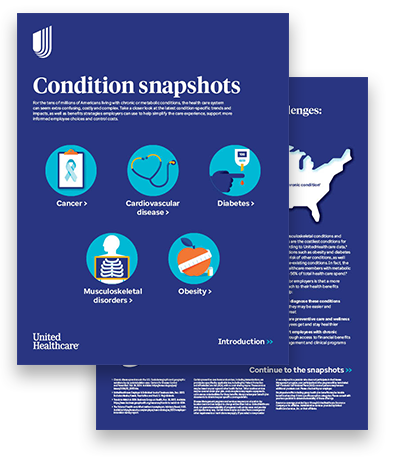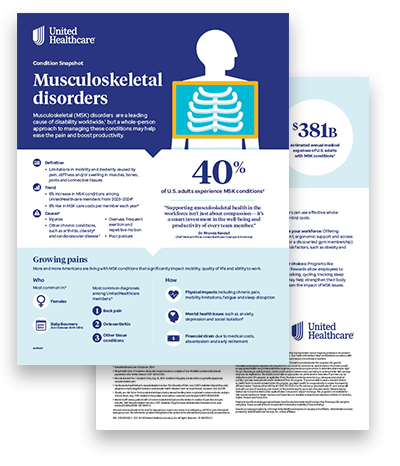Snapshots and strategies for managing complex conditions
These insights and recommendations may help employers better support employees with cancer, cardiovascular disease, diabetes, musculoskeletal disorders and obesity.
Chronic and metabolic conditions are a significant health and financial burden in the U.S., affecting over 129M Americans and consuming a substantial portion of employer health care budgets.1 In fact, about one-third of employer health care spending goes towards managing these conditions, and 28% of UnitedHealthcare members with metabolic conditions accounted for 56% of total health care expenditures.2
These snapshots highlight the overall impact these conditions are having on employee health, productivity and costs across the country as well as within certain populations, and why a whole-person approach to condition management may be key to stunting or even reversing trends related to:
Cancer
Over the past couple years, cancer has continued to be a top cost driver for employers, with about 2M new cases diagnosed annually in the U.S.3 Employers can work to prevent cancer diagnoses (or late-stage cancer diagnoses) by promoting early detection through screenings. For those employees with cancer, employers can provide access to specialized care, as well as offer resources for mental health and advocacy services to help employees navigate their treatment and recovery.
Cardiovascular disease
As the No. 1 cause of death in the U.S. for more than a century, cardiovascular disease is a major health concern for employers and employees alike.4 Employers can help support the cardiovascular health of their workforces by covering cardiac rehabilitation programs, creating heart-healthy workplaces and providing resources for early detection and management, such as blood pressure monitoring and cholesterol screenings.
Diabetes
Diabetes, primarily type 2, affects over 38M U.S. adults5 and has seen a 3% year-over-year increase in prevalence among UnitedHealthcare members.6 Employers can help their employees manage diabetes diagnoses by promoting healthier living, covering at-home screenings and providing continuous glucose monitors (CGMs) to encourage regular monitoring.
Musculoskeletal (MSK) disorders
Musculoskeletal (MSK) disorders are a common source of chronic pain and disability, affecting 40% of U.S. adults and leading to significant health care costs and productivity losses.7 Employers can support employees who are impacted by these types of ailments by providing access to physical therapy and ergonomic assessments, and by promoting early intervention and preventive measures to help reduce the need for more invasive and costly treatments.
Obesity
Obesity is a prevalent metabolic condition that is currently affecting more than 100M Americans.8 To help manage the accompanying health care costs and productivity losses, employers may want to use claims data to understand their population and inform insights, offer weight-management programs that either work alongside or supplement the need for GLP-1s and ensure their health plans incorporate Centers of Excellence (COE) for bariatric surgery that can deliver quality specialized care.





